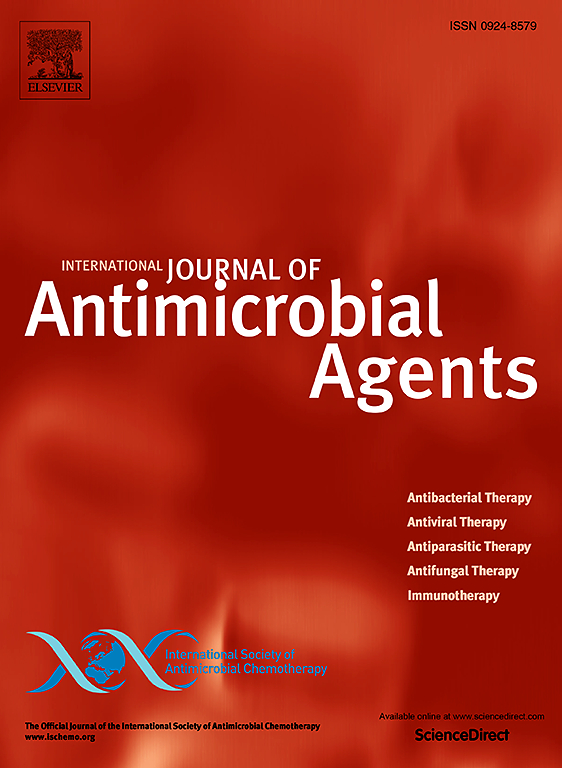Dual therapy based on co-formulated darunavir/ritonavir plus lamivudine for initial therapy of HIV infection: The ANDES randomized controlled trial
IF 4.9
2区 医学
Q1 INFECTIOUS DISEASES
International Journal of Antimicrobial Agents
Pub Date : 2024-08-14
DOI:10.1016/j.ijantimicag.2024.107301
引用次数: 0
Abstract
Background
Tenofovir-containing antiretroviral therapy regimens may have long-term toxicity-related side effects. This study aimed to compare the virological efficacy of co-formulated darunavir/ritonavir plus lamivudine with darunavir/ritonavir plus tenofovir and emtricitabine or lamivudine.
Methods
The ANDES study was a 48-week, phase 4, randomized, open-label, non-inferiority trial in treatment-naïve adults living with human immunodeficiency virus (HIV). Patients were randomized on a 1:1 basis to receive a daily oral regimen of either dual therapy based on a generic co-formulation of darunavir/ritonavir (800/100 mg) plus a generic lamivudine 300 mg pill, or triple therapy with darunavir/ritonavir plus tenofovir/emtricitabine (300/200 mg) or tenofovir/lamivudine (300/300 mg). The primary endpoint was the proportion of patients with a viral load of <50 copies/mL at week 48 in the intention-to-treat population. The US Food and Drug Administration snapshot algorithm and a non-inferiority margin of -12% were used. The secondary objective was to analyse safety in the per-protocol population. This study has been registered at ClinicalTrials.gov (NCT02770508).
Results
Between November 2015 and 31 October 2020, 336 participants were assigned at random to the triple therapy arm (n=165) or the dual therapy arm (n=171). After 48 weeks, 153 patients in the triple therapy group (93%) and 155 patients in the dual therapy group (91%) achieved virological suppression (difference -2.1%, 95% confidence interval -7.0 to 2.9). Drug-related adverse events were more common in the triple therapy group (P=0.04). Two toxicity-related events led to discontinuation in each group.
Interpretation
Co-formulated darunavir/ritonavir plus lamivudine showed non-inferiority and a safer toxicity profile compared with the standard-of-care triple therapy regimen including tenofovir in treatment-naïve patients.

基于共配型达芦那韦/利托那韦加拉米夫定的双重疗法用于艾滋病病毒感染的初始治疗:ANDES 随机对照试验。
背景含有替诺福韦的抗逆转录病毒治疗方案可能会带来与毒性相关的长期副作用。我们旨在评估达鲁那韦-利托那韦联合制剂加拉米夫定与达鲁那韦-利托那韦加替诺福韦和恩曲他滨或拉米夫定相比的病毒学疗效:ANDES研究是一项为期48周的第4期随机、开放标签、非劣效试验,对象是感染了艾滋病病毒的新成人患者。患者按1:1比例随机接受每日口服双重疗法,一种是基于达芦那韦-利托那韦仿制药联合制剂(800/100毫克)的双重疗法,另一种是达芦那韦-利托那韦加替诺福韦/恩曲他滨(300/200毫克)或替诺福韦/拉米夫定(300/300毫克)的三重疗法。主要终点是意向治疗人群中病毒载量在第48周低于50拷贝/毫升的患者比例。我们采用了美国食品药品管理局的快照算法,非劣效边际为-12%。次要目标包括按协议人群的安全性分析。本研究已在 ClinicalTrials.gov 注册,编号为 NCT02770508:2015年11月至2020年10月31日期间,336名参与者被随机分配到三联疗法组(165人)或二联疗法组(171人)。48周后,三联疗法组的153名患者(93%)和双联疗法组的155名患者(91%)实现了病毒学抑制(差异为-2-1%,95%CI为-7-0至2-9)。药物相关不良事件在三联疗法组中更为常见(P=0-04)。每组均有两例毒性相关事件导致停药:解读:与包括替诺福韦在内的标准三联疗法相比,共同配伍的达鲁那韦/利托那韦加拉米夫定对治疗无效的患者显示出非劣效性和更安全的毒性特征。
本文章由计算机程序翻译,如有差异,请以英文原文为准。
求助全文
约1分钟内获得全文
求助全文
来源期刊
CiteScore
21.60
自引率
0.90%
发文量
176
审稿时长
36 days
期刊介绍:
The International Journal of Antimicrobial Agents is a peer-reviewed publication offering comprehensive and current reference information on the physical, pharmacological, in vitro, and clinical properties of individual antimicrobial agents, covering antiviral, antiparasitic, antibacterial, and antifungal agents. The journal not only communicates new trends and developments through authoritative review articles but also addresses the critical issue of antimicrobial resistance, both in hospital and community settings. Published content includes solicited reviews by leading experts and high-quality original research papers in the specified fields.

 求助内容:
求助内容: 应助结果提醒方式:
应助结果提醒方式:


